Read Chinese Healing Exercises Online
Authors: Steven Cardoza
Tags: #Taiji, #Qi Gong, #Daoist yoga, #Chinese Healing, #Health, #medicine, #remedy, #energy
Chinese Healing Exercises (28 page)
In healthy men under forty years old, doing this once or twice a month is sufficient. In older men once a week is recommended, and in those with painful, difficult, or frequent urination, (in the absence of any diagnosed condition requiring medical attention), twice a week or more, at whatever frequency best reduces the uncomfortable symptoms, may be necessary. Once the symptoms abate, the frequency may be reduced.
8. For Women OnlyâBreast Massage
In Daoist and other Chinese practices, there are many variations to the Breast Massage, which can be practiced for different purposes. This version is specifically to promote a woman's general and sexual health.
Women are hormonally more complex than men, with a correspondingly greater degree of hormonal interrelationships. The mammary glands and the associated ducts within the breasts themselves are responsible for the production and transportation of breast milk during lactation. The breasts also respond to the sex hormones estrogen and progesterone produced in the ovaries, accounting for changes in breast size and sensitivity, among other things, that many women experience throughout the menstrual cycle. Oxytocin, a hormone produced in the hypothalamus of the brain, usually from nipple stimulation (as relates to the breasts), is primarily responsible for sexual arousal (bringing on or inducing labor, signaling the beginning and continuation of lactation) and for states of mental and emotional well-being and stress relief. It is further associated with learning and memory.
From the Chinese perspective, all hormones are a type of Jing essence, substances that nourish and rejuvenate the body, and sexual essences are particularly potent toward those ends. Additionally, a number of acupuncture meridians directly run through the breasts, providing specific energetic connections and associations. Many of those meridians begin at the feet and end within the head, indicating the whole body connection and their influence on mental and emotional states. The Kidney meridian runs directly through the genitals and has many associations with sexual health and function. In the region of the breasts, it is medial, that is, nearer to the breastbone.
The Liver meridian circles the genitals and runs almost through the center of the breast, although the last needled point on the Liver meridian is just below the breast. Most menstrual and many other gynecological disorders are treated primarily through the Liver. The external, needled portion of the pericardium, or heart protector, meridian begins just beyond the outer side of the nipple. Through the pericardium's association with the heart, it's easy to understand its connection to love and other bonding emotions. The Spleen meridian lies just outside the nipple, beyond the Pericardium meridian, and the Stomach meridian runs directly through the nipple and centerline of breast. The Spleen and Stomach are a Yin-Yang organ pair, with related functions. The Spleen in particular plays a role in generating blood, so the menstrual connection is easy to understand, and it can readily be influenced by the Liver (especially noticeable when emotional upsets throw off appetite and digestion).
In this practice, you can wear a light shirt or none at all. You could possibly wear a light sports bra with no underwire, but otherwise a bra will be too restrictive and dull sensation, so it's not advisable. If you're able, sit on the floor with either heel placed at the opening of your vagina, lightly touching your clitoris, and your other leg either extended or bent in front of you. If you can't get into that position, sit on a chair with a tennis ball, rolled sock, or something else that is comparably firm yet not too hard placed at the opening of your vagina. The gentle contact stimulates the acupuncture meridians in that region, and may additionally stimulate a hormone response that will enhance the benefits of this exercise. Rub your hands together until they are comfortably warm, indicating that you've brought qi and blood to your hands. Place your hands on your breasts, and feel the warmth from your hands penetrating your breast tissue.
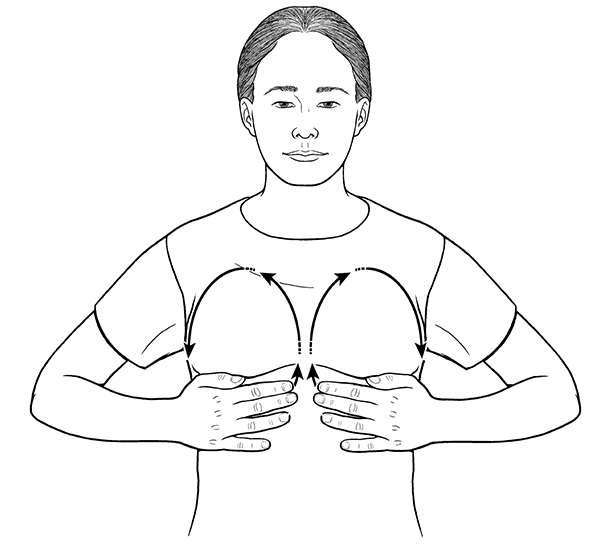 Figure 9.8A (For Women OnlyâBreast Massage)
Figure 9.8A (For Women OnlyâBreast Massage)
For most women, and for most health purposes, you will want to circle your hands upward along your breastbone
(
Fig 9.8A
),
outward over the tops of your breasts, down the outside of your breasts
(
Fig 9.8B
on next page
),
and inward toward your breastbone below your breasts. Circle thirty-six times. This stimulates qi flow through all the related acupuncture meridians discussed above, and is a dispersal technique, which scatters any stuck qi that may be gathered around your breast.
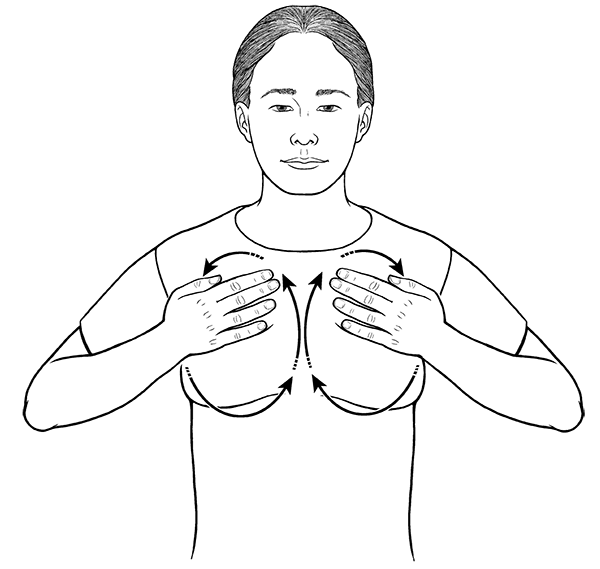 Figure 9.8B (For Women OnlyâBreast Massage)
Figure 9.8B (For Women OnlyâBreast Massage)
Dispersing stagnation in the breasts is important, since almost all physical changes are preceded by energetic ones, which is why paidagong is beneficial as discussed elsewhere throughout this book. Some physical changes are relatively benign, such as when breasts become enlarged and tender premenstrually. This Dispersal technique can relieve that tenderness. While most effective if performed daily, it should be begun at least a few days before the expected onset of monthly breast tenderness. In this case, one hundred circles, performed up to twice daily, is recommended. If a woman is nursing, even if her breasts are tender, Dispersing is not recommended as it may reduce lactation. Once she has stopped nursing, this practice may be resumed.
In other cases when qi gets stuck in the breasts, over time it can cause fibrocystic lumps, cysts, and even cancer. It is common for qi to stagnate in the breasts due to strong lingering emotions or physical trauma. In athletic women, even jogging has been known to cause problems, both from when a woman's arms repeatedly rub or bump the sides of the breasts, and from the bouncing of insufficiently supported breasts creating microtrauma within breast tissue.
For younger women who may have small breasts and want to try to enlarge them, and for women who have insufficient lactation while nursing, Gathering should be performed instead of Dispersal. Gathering is done exactly as Dispersal, except the direction of the circles is reversed. This will bring more qi to the breasts. Women with very small breasts may have a hormonal insufficiency or imbalance. (Breast size alone is not enough to make that determination and other factors must be considered by a health professional.) In that case, bringing more qi to the breasts will not be harmful in younger women, as the practice can remedy the imbalance. Since this is being done for a specific purpose as opposed to for general health, this is another case where one hundred circles twice a day is recommended. After six months (nine months at the longest), if the breasts have not enlarged at least some, the practice will not be of help and Dispersal should be practiced for general health. Since an increase in local, nonmuscular tissue is the aim of this practice, nine months is not an unreasonably long amount of time in which to expect results. Once the breasts have reached their desired size, the Gathering practice should be reduced to thirty-six circles once a day, and interspersed with Dispersal a few times a week to prevent potential qi stagnation. For insufficient lactation, one hundred circles twice a day is also recommended. Once nursing has stopped, Dispersal should be resumed for general health purposes.
Ten
Abdominal/Internal Organ Massage
Abdominal massage is a very large topic, and entire books have been devoted to it. At professional levels, it can takes many weeks of training to get acquainted with just the basics, and months or years to master. In part, it's because the abdomen contains all major internal organs (except the heart and lungs): liver, gall bladder, stomach, spleen, pancreas, kidneys, urinary bladder, and large and small intestines. Thus, so much of the body's overall health and functionality are affected. It contains the lumbar and lower thoracic regions of the spine and the related nerves that enter and exit the spine at those levels. While it may be difficult to believe, the front of that part of the spine can be accessed in some deep massage practices. The abdomen is also an access region for a major nerve plexus (the solar plexus), located just below the breastbone, as well as for lymphatic vessels and tissues and blood vessels, including the aorta, one of the major arteries exiting the heart.
In Chinese energetics, the abdomen contains the lower Dantian, the energy center that influences everything to do with physicality. In Japanese energetics it is the seat of the
hara
(translated as “center”), similar to the Dantian in location and function but with slightly broader medical applications, commonly used diagnostically in Japanese acupuncture and acupressure. Depending on the type and purpose of abdominal massage, most or all of these things need to be taken into account.
Here are a couple of practices that are safe for anyone, easy to learn, and effective for what they are designed to do. While you don't need to know much anatomy, a little familiarity is helpful and will be provided.
The first practice is the more physical of the two, and has a few variations. The primary method presented is best suited for people with healthy to underactive digestive and eliminative functions (having less than one to up to three normal bowel movements a day). It improves digestion and elimination, tones the gastrointestinal system, brings more blood into all the abdominal organs, disperses areas of congested blood, body fluids, and other toxic accumulations, improves breathing, and with some practice assists in improving organ mobility (the springiness of the organs and the suspensory ligaments to which they are attached) and organ motility (the natural rhythms and pulsations generated by and within each organ, indicating its vitality and healthy functionality).
1. The Physical Practice
Lie on your back on a mat, on a thick rug on the floor, or on a firm mattress. You can keep your legs extended normally, or bend your knees and place your feet flat on the floor. Many people prefer the bent-knee position because it naturally releases tension in the abdominal muscles, allowing for a more comfortably deep massage.
Next, decide if one massaging hand alone or both together will work best for you. If your fingers are strong and free of pain, you can use one hand in this practice. In that case, either compress your fingers together side by side for support, or wrap the tips of your four fingers around the tip of your thumb so that the tips of all fingers are touching the thumb, with no one fingertip protruding farther than the others
(
Fig 10.1
).
This is a hand position used in the Chinese massage practice of tuina, and it is also the beak or whip hand used in the taiji posture Single Whip. If your fingers are not very strong, or if you have joint pain in your fingers or want a deeper massage, you can use two hands in this way. Place the backs of the fingers of each hand together, again with no finger protruding farther than any of the others, so that you have two rows of four fingers at roughly the same height
(
Fig 10.2
).
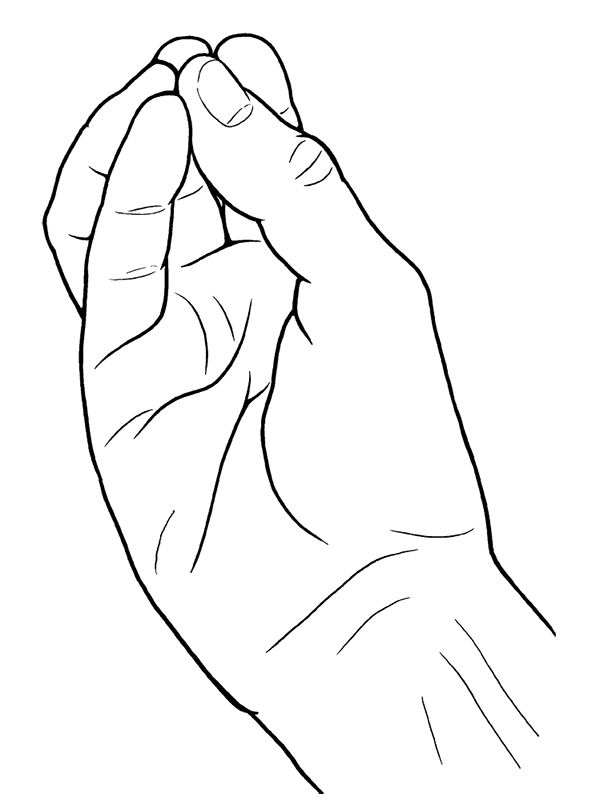 Figure 10.1 (The Physical Practice)
Figure 10.1 (The Physical Practice)
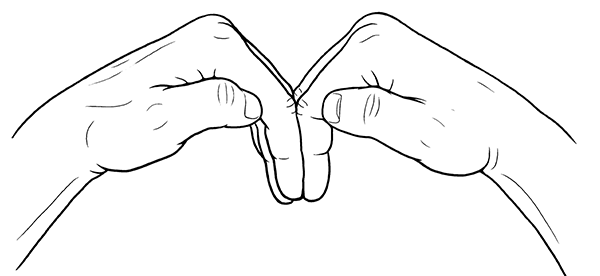 Figure 10.2 (The Physical Practice)
Figure 10.2 (The Physical Practice)
Now, using one or both hands, place the tips of your fingers just below your belly button
(
Fig 10.3
).
Press straight down toward the floor, to whatever depth feels comfortable to you. Make small clockwise circles. Do not let your fingers slide over the surface of your skin, but direct the force downward so that the muscles and internal organs just below your fingertips move in that small clockwise circle. Do this for just a few seconds. Next, partially release the pressure, and slide your fingertips clockwise, a bit to the right and slightly upward, reapply full pressure, and make the small clockwise circles. As you continue this pattern (straight pressure downward, small clockwise circles, release some of the pressure, move your hand to the next location clockwise, reapply full pressure, etc.), your hand(s) will circle your entire belly button in a clockwise circle. The internal organ primarily affected in this circle is the small intestine.
When you arrive at your starting point, closing the large clockwise circle, move your hand slightly lower below your belly button, and repeat all of the above, making a larger clockwise circle around your belly. The small intestine is still influenced in this circle. Consider your starting position below your belly button as 6 o'clock. From the 8 o'clock to 4 o'clock positions, you're also influencing the large intestine. Depending on the size of this circle, women may find their ovaries at the 7â8 o'clock and 4â5 o'clock positions. While light massage is beneficial to the ovaries, avoid deep massage with strong pressure on them. Between the 7 and 5 o'clock positions, the upper border of the uterus can be felt. Massaging the uterus is always beneficial, and is often very effective in relieving menstrual cramps. At roughly the 3 and 9 o'clock positionsâat the sides of your belly slightly above the height of your navelâyour fingers will be over the front of your kidneys. They are closer to the back of your body, but for people who are very thin, or for people who are able to comfortably use deep pressure, you may feel a firmness or hardness at that location, about the size of your fist. Those are your kidneys. Light to moderate pressure on them is okay, as long as that pressure does not produce pain. The kidneys are fairly delicate organs, and you should never use strong pressure on them. If you don't feel your kidneys, that's fine too. The wave motion you send through your body by the circling massage will still reach them and be beneficial.
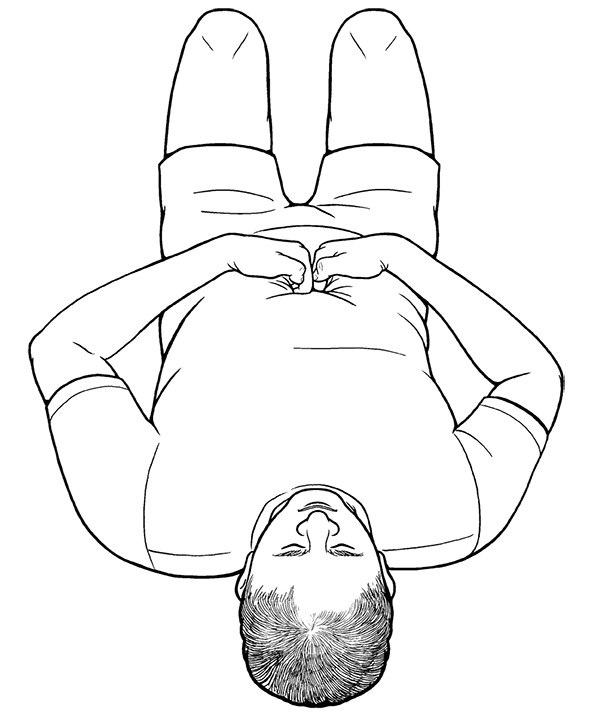 Figure 10.3 (The Physical Practice)
Figure 10.3 (The Physical Practice)
When you arrive at your starting point again, repeat all of the above once more, making the largest circle around your belly. Begin just above the center of your pubic bone. The urinary bladder is located there, so you may be more comfortable if you void your bladder before beginning this massage. Women will find the main body of the uterus here as well. In this circle, you will be accessing the large intestine along the sides of your belly and below your ribs. This time, make sure your fingertips contact your ribs during the upper half of the large circle, and direct some of the fingertip pressure under your ribs. That will directly massage your liver and gall bladder (just below your ribs on the right side of your abdomen), and your stomach, which is below your ribs near the middle on the left of your abdomen. To some extent it will indirectly (for most nonprofessional self-massagers) influence your spleen and pancreas, also on the left. Your pancreas is just behind your stomach and to the left, and your spleen is farther to the left and slightly lower.
To benefit your diaphragm, which is also a muscle that responds to massage like other muscles, try to hook your fingers under your ribs so you can massage the inner surface of the ribs. This is near where the diaphragm attaches to the front of your body, and massaging here will relax your diaphragm, allowing for fuller, deeper breathing. For most people, it will be easiest to do this at your lowest ribs near the sides of your belly, and will get more difficult and sensitive as you approach your midline below your breastbone, where more muscle attachments and the solar plexus create more tension. With practice, you will be able to open that middle region more. Don't force it; be gentle but diligent. When you arrive at the center of your pubic bone once more, that ends the general abdominal massage.
The first variation is for people who typically have more than three bowel movements a day, or chronic loose bowels or diarrhea. Frequently these people also have low energy or fatigue, have a poor appetite, and may feel chilled easily. This variation is performed exactly like the general massage, except that the direction of both the small fingertip circles and three larger circles are done in a counterclockwise direction. Some get better results starting with the large circle, fingertips just above the pubic bone, the second two circles getting gradually smaller, ending with fingertips just below the navel. In addition to reducing the activity of the intestines, that way brings more qi to the center, the Dantian, helps to build energy. Experiment to see what works best for you. In either case, over time you should see an improvement in bowel function, especially when including other exercises from this book in your daily practice.
The next variation is for people who experience some discomfort, including mild to moderate pain when doing the abdominal massage. This is not uncommon, and usually is no cause for concern. You may encounter areas of pain, tenderness, or hardness. That discomfort can be caused by a variety of factors, including simple qi stagnation, gas, bowel obstruction or fecal impaction, tension in the diaphragm, or muscle tenderness from exercise, injury, or a deep spasmed muscle. Many people feel physically, emotionally, or psychologically vulnerable around the abdomen, and they may guard or armor that part of the body unconsciously. When that guard is penetrated, even by oneself, it can be uncomfortable or painful. There is a possibility of pain indicating something more serious, like an inflamed appendix, an aortic aneurysm, diverticulosis, gall or kidney stones, or other internal organ disease, but usually those more serious conditions will present with significant pain and other symptoms. They need to be treated by your physician. If you're at all in doubt, seek professional medical advice. The massage as described here will not
cause
any serious problems, but will only shine a light on a problem that already exists. Otherwise, in the absence of serious pain, in this variation work on those uncomfortable areas a little longer than the other more comfortable areas. Being careful not to apply so much pressure that you increase any pain or discomfort you feel, massaging longer will gradually disperse that discomfort, indicating that the underlying condition causing the discomfort is being resolved. This may not happen all at once. Keep track of the location of the discomfort, and over a number of days or weeks, see if it lessens or changes location. Either can indicate an improvement in the underlying condition. If your belly is very relaxed, remember that it's possible to contact the front of your spine along the midline of your belly, and the hardness you may encounter in that case is normal.
2. The Energetic Practice
The second practice uses very light touch and is primarily energetic in nature. As in the abdominal massage, there are a couple of variations you can try. In all methods, begin by rubbing your hands together until the palms are warm. This brings blood to your palms, and blood carries qi. The Chinese medical phrase “blood is the mother of qi” means that qi grows out of and is carried by blood. In these energetic practices, you want to have as much qi in your hands as possible to get the best results.

